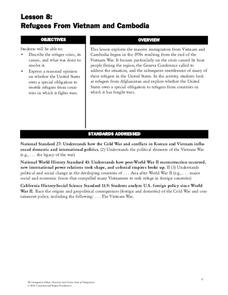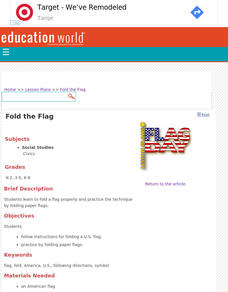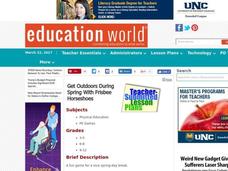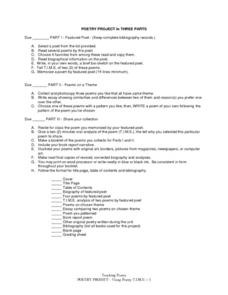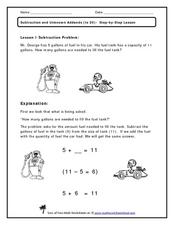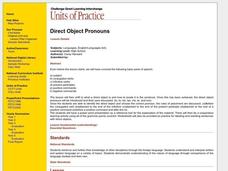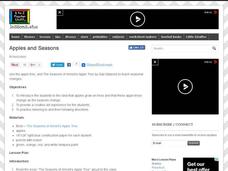Safe Drinking Water Foundation
Water Bottles Everywhere
Young environmentalists examine how water bottle use is polluting the waters on our earth. In groups, your students study the handout on their assigned topic and present their findings to the rest of the class. Leading up to this lesson,...
Baylor College
There's Something in the Air
Clever! In order to compare indoor and outdoor dispersal rates for the movement of gases and particles through air, collaborators will participate in a classroom experiment. Set up a circular grid and set students on lines that are...
Constitutional Rights Foundation
Refugees From Vietnam and Cambodia
The United States may have pulled its troops from the Vietnam War in 1973, but the conflict was far from over for the citizens living in Asia at the time. An informative resource lets learners know about the wave of over 220,000...
Fluence Learning
Writing About Informational Text: Music and the Brain
Even if you've never picked up a musical instrument, chances are that music has directly impacted your mental and emotional development. Sixth graders engage in a reading activity in which they read two articles on the impact of music on...
Get Set for School
Capital Formation Chart
Practice makes perfect, especially when it comes to handwriting. These reference charts are excellent support for young children still developing their ability to print upper- and lower-case letters
Curated OER
Fold the Flag
Learners follow directions to fold a flag properly. They practice on paper flags first and then use a real United States flag. They also examine the history of the flag.
Curated OER
Pop-it...Stop-it
Students observe how certain geometric shapes can be used to make some structures rigid and others flexible. The activity involves construction of a 30-60 right triangle, folding while following directions, and identifying polygons.
NorthEast Ohio Geoscience Education Outreach
Ecosystems and Change
Pairs of ecologists select an animal and investigate an ecosystem from its point of view. This simple lesson involves Internet research and putting together a presentation of collected information.
Curated OER
3-D Multicultural Ornaments
Students create and color three-dimensional ornaments reflecting December's many cultural celebrations. They decide which symbol they wish to create as an ornament, draw or trace the outline of the symbol, and follow directions as they...
Curated OER
Picture Yourself in an Ornament
Students create an ornament with their photo inside of it. To create the personal memento, students observe demonstrations and follow directions. Students experience making a craft and giving the memento to a family member.
Curated OER
Frisbee Horseshoes
Pupils follow directions and practice the skill of throwing a Frisbee toward a target. They then play a Frisbee game and practice working as a team while keeping score on their own.
Curated OER
Map Readng And Giving Directions
Students read a story to create the context for the lesson. Then they are given or create a community map. Then students use the scenario of being lost in order to role play giving directions to a partner to find a destination. The...
Curated OER
Bronx Zoo
Students prepare for a field trip to the Bronx Zoo. They use maps and descriptions of animal exhibits to give and interpret directions on how to navigate the zoo. They play games, participate in pairwork and whole class discussion.
Teaching English
Poetry Project in Three Parts
It’s poetry T.I.M.E! Individuals use the T.I.M.E. format (T = Title, thought, and theme; I = Imagery and figurative language; M = music and sound; E = emotion) to study a poet, collect poems that have a similar theme, and create a...
Curated OER
Celestial Dreams Pencil Cup
Students create a visual reminder of their goals and aspirations. Then they use recycled material as an armature for sculpting a useful container. Students also select symbols for their cups reflecting their dreams and follow directions...
Curated OER
Asking For Directions
Students draw a map of their surrounding area using appropriate landmarks and identifying characteristics. Students ask for and give directions to locations found on their maps to their partner. This lesson is intended for students...
Curated OER
Subtraction and Unknown Addends (to 20)
How many more gallons of fuel does Mr. George need to fill his car to capacity? This word problem uses the unknown addend strategy to get scholars subtracting and thinking about the relationship between mathematical operations. There is...
Curated OER
Direct Object Pronouns
Students work together to identify parts of a sentence, and decide where the direct object pronoun should go and what it should replace.
Curated OER
Apples and Seasons
Students identify and interpret the idea that apples grow on trees and that these apple trees change as the seasons change. Then they gain knowledge of seasonal changes through a creative art experience for the students. Students also...
Curated OER
Following the Blood
Pupils rehearse a scene from Julius Caesar and analyze how the physical aspects of stage direction impact the audience. In this Julius Caesar lesson plan, students use blood in the scene and analyze the direction and where the blood is...
Curated OER
Beyond Demographics
Students study the culture of the Dominican Republic. In this Peace Corps lesson, students watch, "Destination: Dominican Republic." Students also examine primary source materials on the nation and discuss their findings.
Scholastic
Perfect Postcards: Illinois
Connect the geography and history of Illinois using an art-centered lesson on the railroads. The railroad connected once-distant places, particularly in the Midwest. Using research, class members create postcards of fictional cross-state...
Curated OER
Little Red Hen Helpers
Students classify different foods into the groups on the food pyramid. They discuss what products are made from wheat. They complete the lesson plan by following directions on a recipe.
Curated OER
Serendipity Shape Collages
Students cut or tear a variety of geometric paper shapes and follow directions to decorate them. They define and create a pleasing collage. Afterward, they identify the names of shapes used in their collages




